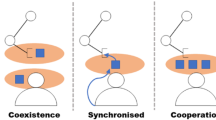Abstract
Social interaction between humans takes place in the spatial environment on a daily basis. We occupy space for ourselves and respect the dynamics of spaces that are occupied by others. In human-robot interaction, spatial models are commonly used for structuring relatively far-away interactions or passing-by scenarios. This work instead, focuses on the transition between distant and close communication for an interaction opening. We applied a spatial model to a humanoid robot and implemented an attention system that is connected to it. The resulting behaviors have been verified in an online video study. The questionnaire revealed that these behaviors are applicable and result in a robot that has been perceived as more interested in the human and shows its attention and intentions earlier and to a higher degree than other strategies.
Similar content being viewed by others
References
Fong T, Nourbakhsh I, Dautenhahn K (2003) A survey of socially interactive robots. Robot Auton Syst 42(3):143–166
Lütkebohle I, Peltason J, Schillingmann L, Elbrechter C, Wrede B, Wachsmuth S, Haschke R (2009) The curious robot—structuring interactive robot learning. In: International conference on robotics and automation, Kobe, Japan, 2009. IEEE, New York
Breazeal C, Takanishi A, Kobayashi T (2008) Social robots that interact with people. In: Springer handbook of robotics. Springer, Berlin, pp 1349–1369
Schegloff EA (2002) Opening sequencing. In: Katz JE, Aakhus M (eds) Perpetual contact: mobile communication, private talk, public performance. Cambridge University Press, Cambridge, pp 326–385
Kendon A (1990) Conducting interaction: patterns of social behavior in focused encounters. Cambridge University Press, New York
Shiomi M, Kanda T, Ishiguro H, Hagita N (2010) A larger audience, please!: encouraging people to listen to a guide robot. In: HRI ’10: Proceeding of the 5th ACM/IEEE international conference on human-robot interaction
Shiomi M, Sakamoto D, Kanda T, Ishi CT, Ishiguro H, Hagita N (2008) A semi-autonomous communication robot: a field trial at a train station. In: HRI ’08: Proceedings of the 3rd ACM/IEEE international conference on human robot interaction
Pitsch K, Kuzuoka H, Suzuki Y, Luff P, Heath C, Yamazaki K, Yamazaki A, Kuno Y (2009) The first five seconds: contingent step-wise entry as a means to secure sustained engagement in human-robot-interaction. In: International symposium on robot and human interactive communication, Toyama, Japan, September 2009
Goodwin C (1981) Conversational organization: interaction between speakers and hearers. Academic Press, New York
Kuzuoka H, Pitsch K, Suzuki Y, Kawaguchi I, Yamazaki K, Kuno Y, Yamazaki A, Luff P, Heath Ch (2008) Effects of restarts and pauses on achieving a state of mutual gaze between a human and a robot. In: CSCW
Hall ET (1968) Proxemics. Curr Anthropol 9(2/3):83
Tasaki T, Komatani K, Ogata T, Okuno H (2005) Spatially mapping of friendliness for human-robot interaction. In: Proc of IEEE/RSJ international conference on intelligent robots and systems, Edmonton, August 2005, pp 52–526
Nakauchi Y, Simmons R (2000) A social robot that stands in line. In: Proc of the IEEE/RSJ intern conference on intelligent robots and systems, pp 357–364
Pacchierotti E, Christensen HI, Jensfelt P (2006) Evaluation of passing distance for social robots. In: IEEE workshop on robot and human interactive communication (ROMAN), Hartfordshire
Kirby R, Simmons R, Forlizzi J (2009) Companion: a constraint optimizing method for person-acceptable navigation. In: IEEE international symposium on robot and human interactive communication (RO-MAN), September 2009, pp 607–612
Takayama L, Pantofaru C (2009) Influences on proxemic behaviors in human-robot interaction. In: Intelligent robots and systems (IROS), St Louis, MO
Dautenhahn K, Walters M, Woods S, Koay KL, Nehaniv CL, Sisbot A, Simeon T (2006) How may I serve you?: a robot companion approaching a seated person in a helping context. In: Proceedings of the 1st ACM SIGCHI/SIGART conference on human-robot interaction
Koay KL, Syrdal DS, Walters ML, Dautenhahn K (2007) Living with robots: investigating the habituation effect in participants: preferences during a longitudinal human-robot interaction study. In: 16th IEEE international conference on robot & human interactive communication
Huettenrauch H, Eklundh KS, Green A, Topp EA (2006) Investigating spatial relationships in human-robot interaction. In: Proceedings of the 2006 IEEE/RSJ international conference on intelligent robots and systems, pp 5052–5059
Yamaoka F, Kanda T, Ishiguro H, Hagita N (2008) How close? A model of proximity control for information-presenting robots. In: HRI
Shiomi M, Kanda T, Ishiguro H, Hagita N (2006) Interactive humanoid robots for a science museum. In: HRI’06. Salt Lake City, Utah, USA
Pitsch K, Wrede S, Seele J-Ch, Süssenbach L (2011) Attitude of German museum visitors towards an interactive art guide robot. In: HRI2011
Yamazaki K, Kawashima M, Kuno Y, Akiya N, Burdelski M, Yamazaki A, Kuzuoka H (2007) Prior-to-request and request behaviors within elderly day care: implications for developing service robots for use in multiparty settings. In: ECSCW
Schegloff EA (1998) Body torque. Soc Res 65(3):535–596
Kuzuoka H, Suzuki Y, Yamashita J, Yamazaki K Reconfiguring spatial formation arrangement by robot body orientation. In: HRI ’10: proceeding of the 5th ACM/IEEE international conference on human-robot interaction
Breazeal C, Scassellati B (1999) How to build robots that make friends and influence people. In: Intelligent robot systems (IROS), Kyonjiu, Korea, pp 858–863
Muhl C, Nagai Y (2007) Does disturbance discourage people from communicating with a robot. In: The 16th IEEE international symposium on robot and human interactive communication, Jeju, Korea
Beuter N, Spexard T, Lütkebohle I, Peltason J, Kummert F (2008) Where is this?—gesture based multimodal interaction with an anthropomorphic robot. In: International conference on humanoid robots, Daejeon, Korea. IEEE-RAS, New York
Hackel M, Schwope M, Fritsch J, Wrede B, Sagerer G (2006) Designing a sociable humanoid robot for interdisciplinary research. Adv Robot 20(11):1219–1235
Lütkebohle I, Hegel F, Schulz S, Hackel M, Wrede B, Wachsmuth S, Sagerer G (2010) The Bielefeld anthropomorphic robot head “flobi”. In: IEEE international conference on robotics and automation, Anchorage, Alaska. IEEE, New York
Hegel F (2010) Gestalterisch konstruktiver Entwurf eines sozialen Roboters. PhD thesis, Bielefeld University
Viola P, Jones M (2001) Rapid object detection using a boosted cascade of simple features. In: Computer vision and pattern recognition (CVPR), vol 1, pp 511–518
Kendon A (1967) Some functions of gaze-direction in social interaction. Acta Psychol 26:22–63
Author information
Authors and Affiliations
Corresponding author
Additional information
This work has been supported by the German Research Society (DFG) within the Collaborative Research Center 673, Alignment in Communication.
Rights and permissions
About this article
Cite this article
Holthaus, P., Pitsch, K. & Wachsmuth, S. How Can I Help?. Int J of Soc Robotics 3, 383–393 (2011). https://doi.org/10.1007/s12369-011-0108-9
Accepted:
Published:
Issue Date:
DOI: https://doi.org/10.1007/s12369-011-0108-9




